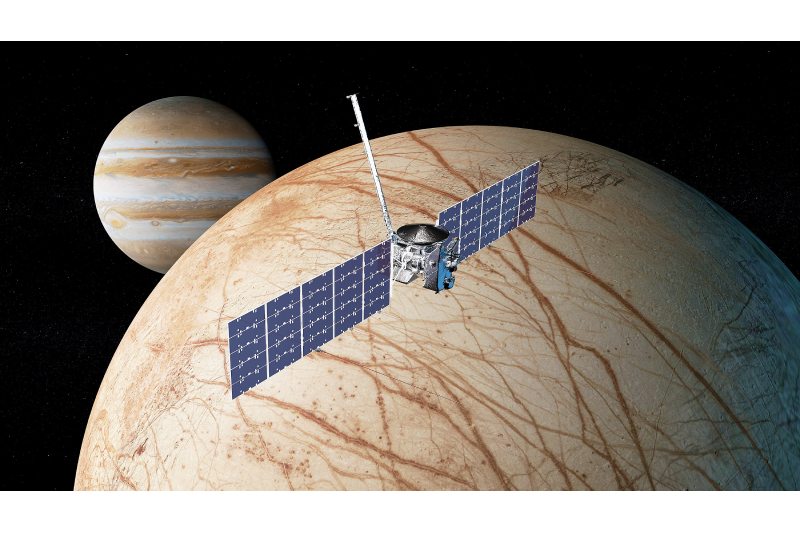According to a recent experiment, NASA’s next Europa Clipper spacecraft may be able to collect a single ice grain that was blasted from Jupiter’s ocean moon Europa, which might potentially provide evidence of extraterrestrial life.
“It might be easier than we thought to find life, or traces of it, on icy moons with suitable instrumentation, like the SUrface Dust Analyzer on NASA’s Europa Clipper space probe,” said Frank Postberg of Freie Universität Berlin in a statement. Postberg is one of the co-authors of a recent research that details the results.
Europa Clipper, the first expedition to this frozen moon of Jupiter, is presently slated to launch in October 2024. After arriving in 2030, it is anticipated to conduct about 50 close fly-bys of Europa, gliding across the frozen surface at as low as 25 kilometers (16 miles). Finding out more about the thickness of the ice cover above Europa’s underground ocean and its habitability is the main goal of the mission. To be clear, the expedition is not intended to locate life, but scientists are beginning to realize that there might be a way.
Enceladus is another ocean moon of Europa; it is a small, ice body that orbits Saturn, the planet with rings. When plumes of water vapor began to emerge from Enceladus’ ocean in 2006, the Cassini mission to Saturn saw them. These surface fissures were given the nickname “tiger stripes.”
A plume resembling this was seen by the Hubble Space Telescope in 2014, rising 200 kilometers (125 miles) above the surface of Europa. It observed another plume coming from the same spot two years later. Afterwards, NASA researchers discovered in 2018 that the defunct Galileo probe—which was in orbit around Jupiter from 1995 to 2003—had in fact passed through a plume.
Scientists led by Fabian Klenner of the University of Washington in Seattle looked at whether the Surface Dust Analyzer (SUDA) onboard Europa Clipper could be able to identify any life transported up from the ocean on the plume, given the possibility that the spacecraft may possibly fly through an icy moon plume. As the moon is continuously hit by micrometeorites, SUDA is intended to research surface ice and dust particles that splatter into space. However, it might also be able to examine ice grains in the plumes.
Instead of simulating high-velocity collisions of ice grains on the instrument in a lab, Klenner’s team used a thin, quick-moving stream of water vapor that was injected into a vacuum chamber with a bacterium known as Sphingopyxis alaskensis. Found in the sea waters off the coast of Alaska, Sphingopyxis alaskensis can withstand low temperatures and a lack of nutrients.
It’s among the closest things we have to an Earthly life form that could endure in the water of Europa.
Split image of a grey, damaged planet with a white blob labeled ‘plume’ on the left of each is displayed against a fuzzy, marbled blue background.
The bacteria “are extremely small, so they are in theory capable of fitting into ice grains that are emitted from an ocean world like Enceladus or Europa,” stated Klenner in the announcement, which is more relevant to the Europa Clipper’s ability to detect such life.
The water jet broke up into droplets that turned into ice grains due to the vacuum. The grains were then examined using a mass spectrometer, simulating the analysis that SUDA will perform on any grains that it encounters in the actual world. The experiment’s findings demonstrated that it was possible to identify Sphingopyxis alaskensis—or at least the components that contribute to ocean scum—by examining a single ice grain.
“We have shown that even a tiny fraction of cellular material could be identified by a mass spectrometer on board a spacecraft,” Klenner stated. “Our results give us more confidence that using upcoming instruments, we will be able to detect lifeforms similar to those on Earth, which we increasingly believe could be present on ocean-bearing moons.”
DNA cannot be identified by Europa Clipper’s equipment, however SUDA can identify fatty acids and lipids, which are components of biological cell membranes. The lipid membranes in Earth’s seas are responsible for the thin layer of ocean scum that forms on the surface of the water. The peculiar smell of sea spray is caused by this muck.
“For me, it is even more exciting to look for lipids, or for fatty acids, than to look for building blocks of DNA, and the reason is because fatty acids appear to be more stable,” Klenner stated.
There is a better possibility that the biological components will survive intact long enough for Europa Clipper to identify life in the seas surrounding Europa that contains lipid membranes.
